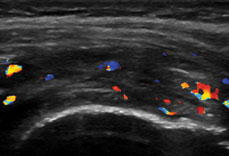Leucocyte platelet-rich fibrin with rotator cuff repair enhances early vascularization
At 12 months, patients treated with leucocyte platelet-rich fibrin did not show improved healing or differences in tendon thickness vs. controls.
In patients with chronic rotator cuff tears, applying leucocyte platelet-rich fibrin increased vascularization following arthroscopic repairs, but did not improve shoulder function or tendon healing rates, according to a presentation at the American Shoulder and Elbow Surgeons 2012 Open Meeting.
“Although rotator cuff repairs with [leucocyte platelet-rich fibrin] L-PRF showed an increased vascularization at 6 weeks at the insertions, it did not increase the watertight healing at 12 months measured by MRI,” Matthias A. Zumstein, MD, told Orthopaedics Today Europe. “This is consistent with most other published studies,” he said of the work performed by Pascal Boileau, MD, in the Department of Orthopaedic Surgery and Sports Traumatology at L’Archet Hospital, in Nice, France.
In the study, 35 patients scheduled for arthroscopic cuff repair were prospectively randomized in two groups before surgery and followed up. Intraoperatively 17 patients were treated with L-PRF during arthroscopic rotator cuff repair and were compared to 18 control patients who did not receive an L-PRF application.

Matthias A. Zumstein
The team manufactured the L-PRF used in the study according to Choukroun’s protocol.
“After preparation of the L-PRF [fibrin] clot, we put it in between the tendon and the bone before we performed the last row in a transosseous-equivalent double-row construct” in the study patients, Zumstein said at the meeting.

The extent of vascularization on Power Doppler ultrasonography in a patient’s left shoulder is shown 6 weeks after applying leucocyte platelet-rich fibrin growth factors.
Image: Zumstein MA
The investigators used Power Doppler ultrasonography to measure vascularization and arthro-MRI to analyze tendon thickness and quality, as well as anatomic watertight healing at 6 weeks and at 3 months for both groups.
In his presentation Zumstein said vascularity on Doppler in both groups was graded as 0 for no spots, 1 for one spot and 2 for multiple spots. In the L-PRF group vascularity was 10.1 vs. 3.1 in the control group at 6 weeks, which was significantly increased in the active group. Although the results at 3 months showed the vascularization spots remained higher in the L-PRF group vs. controls, they decreased to 7.0 in the active group and increased to 6.5 in the controls, according to the abstract.
“If you analyze healing factors, preoperatively, at 3 and 12 months — tendon thickness and change in insertion quality — there were no differences between the two groups in all the parameters,” Zumstein said at the meeting. At the 12-month follow-up, control-MRI showed similar tendon repair quality in both groups based on the Sugaya III classification and there was similar tendon thickness of 5.3 mm in the L-PRF group and 6.0 mm in the control group.
At all follow-up time periods, there were no complications in either group. Clinical and patient-based outcome scores, tear patterns, age and gender were also similar in both groups. Based on these results, Boileau has stopped using L-PRF growth factors. – by Jeff Craven
Reference:
- Zumstein MA, Rumian A, O’Shea K, et al. Use of platelet- and leucocyte-rich fibrin (L-PRF) improves early vascularization but does not affect late rotator cuff tendon healing: A prospective randomized controlled study. Paper #5. Presented at the American Shoulder and Elbow Surgeons 2012 Open Meeting. Feb. 11. San Francisco.
For more information:
- Pascal Boileau, MD, can be reached at University of Nice-Sophia-Antipolis, 151 Route de St. Antoine de Ginestière, Nice, France; email: boileau.p@chu-nice.fr.
- Matthias A. Zumstein, MD, can be reached at Orthopaedic Sports Medicine, Department of Orthopaedics and Traumatology at University of Bern, Freiburgstrasse 3010, Bern, Switzerland; email: matthias.zumstein@insel.ch.
Disclosure:
- Boileau and Zumstein have no relevant financial disclosures.
